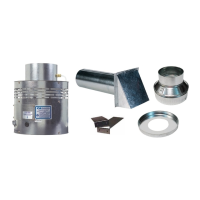page 2
Diagrams A and B and Table 1 show the maximum equivalent length and size of duct pipe that should be
used when installing the CAS system. Using these charts will help ensure that the proper amount of air is
drawn into the structure as needed by the appliance. The defined regions shown correspond to the CAS's
airflow characteristics when using 4" and 6" diameter sheet metal duct pipe and the included orifice ring.
Follow the guidelines below to properly size and setup the CAS.
Determine the maximum input firing rate of the appliance, or the maximum total firing rate of multiple 1.
appliances that will be used.
Position the motorized CAS unit according to the guidelines in the Installation section.2.
Determine where the intake air vent hood will be located based on the recommendations in the 3.
Installation section.
The CAS is equipped with a High/Low motor speed control switch. When calculating the maximum 4.
equivalent feet, determine which speed is appropriate for the application. (Refer to Diagram A or B or
Table 1)
Calculate the total equivalent length of duct pipe including elbows and fittings needed to connect the 5.
CAS unit to the vent hood. (Refer to Diagram A or B or Table 1)
On Diagram A or B, locate the point that corresponds to the firing rate along the horizontal axis and the 6.
equivalent length of the duct pipe along the vertical axis, if using for make up air.
The point should fall within one of the three regions on the table. Each region corresponds to a duct pipe 7.
diameter of 4", 4" using the orifice ring, and 6" respectively. If the point falls near the rightward border
of a particular region then the VRV is not necessary. If the point falls away from the rightward border,
then a VRV is needed to reduce the amount of air drawn in.
GENERAL SYSTEM OPERATION
The thermostat (wall thermostat, or aquastat) calls for heat and energizes a relay which activates the 1.
CAS unit. After the CAS fan has come up to speed, an internal air pressure switch closes and completes
the circuit to allow the burner to fire. If the appliance is power vented, the venter and CAS activate
simultaneously. After the CAS comes up to speed, a pressure switch in the unit closes and allows the
appliance to fire.
After the heating requirement has been satisfied, the thermostat circuit will open and deactivate the 2.
burner and CAS unit.
For power vented systems with a post purge device, the power venter and CAS operate for a period of 3.
time after the burner has shut off to purge remaining flue gases from the vent system.
INSTALLATION SAFETY INSTRUCTIONS
CAUTION: This device must be installed by a qualified installer in accordance with the manufacturer’s
installation instructions.
This combustion air system must be installed by a qualified installer. “Qualified Installer” shall mean an 1.
individual who has been properly trained or a licensed installer.
Plan the system layout before installation to avoid the possibility of accidental contact with concealed 2.
wiring or plumbing inside walls.
Disconnect power supply before making wiring connections to prevent electrical shock and 3.
equipment damage.
SIZING AND SETUP

